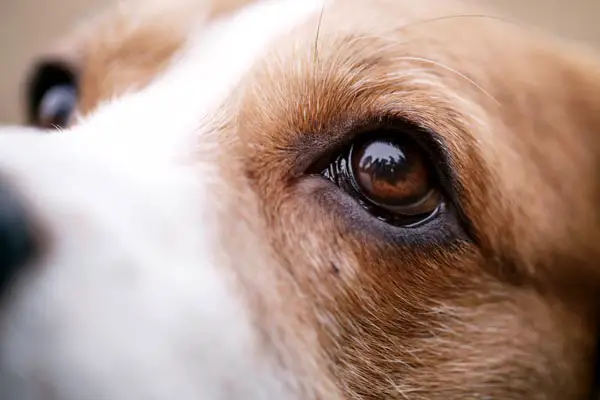Down Syndrome Dogs: The Impossible or Possible?
What is Down Syndrome?
Down syndrome results when the 21st pair of chromosomes suddenly has three copies instead of two containing the genetic information, according to Genetics Home Reference.
Generally, an embryo could not survive when an error like this occurs, but chromosome 21 is rather tiny.
As a result, the embryo can survive at the expense of atypical features and a degree of mental impairment from a mild to moderate level. Trisomy 21 is the most popular cause of the down syndrome.
However, the condition can similarly arise if part of the 21st pair translocates to another chromosome as eggs and sperm are generated.
The additional attachment of information from translocation causes three copies of information to be present.
Genetics plays an important role in many health conditions. In this case, however, down syndrome is not normally inherited.
Instead, it forms from sporadic events during oogenesis (egg production) and spermatogenesis (sperm production).
Can Dogs Exhibit Down Syndrome?
Animals are eukaryotes like humans, so this means they have many of the same cells and biological processes as humans. This life structure makes them susceptible to Down syndrome as well.
Dr. Jennifer Coates, DVM, states humans have 23 pairs of chromosomes, while dogs, in contrast, have 39.
The 21st pair is not responsible for eliciting Down syndrome in both humans and dogs.
Scientific studies on mouse models have revealed that the 16th set of chromosomes houses comparable information to that on the 21st set of humans.
Compared to 1 in 700 human babies who suffer from the condition, dogs do not display the syndrome as often if at all. In fact, down syndrome has not actually been qualified in dogs.
One potential reason is the dog would most likely have a premature death. On top of that, there have not been in-depth studies to analyze dog chromosomes and identify if the condition exists in canines.
Another postulation is dogs simply are not affected at all by Down syndrome. Hence, it is inconclusive at this time, and more research needs to be done on the subject.
What are the symptoms of Down syndrome?
Poor muscle tone and a short neck are two tell-tale signs of Down syndrome. The face likewise has a distinctive appearance marked by a flattened profile and nose with eyes that slant upwards.
The hands will be wide and short with correspondingly short fingers, and the feet have a pronounced groove between the first two toes.
These are the qualified phenotypic traits of Down syndrome in humans as reported by the NIH.
The child’s cognitive and physical development will be delayed in comparison to their peers.
Physical impairments in their muscle tone will be observable as the child tries to learn to sit, stand, roll over and walk.
Their milestone achievements do not happen as quickly, but they gradually meet many milestones during the development.
Individuals with Down syndrome normally do not suffer from severe cognitive impairments.
They may have difficulty paying attention and have a poor sense of judgment. These individuals are more likely to act on impulse and learn slower.
This decreased rate of learning transfers to their acquisition of speech and language development as well.
As stated earlier, it is currently inconclusive as to whether or not dogs suffer from Down syndrome.
This could partially be due to veterinarians mistaking the condition for something else since Down syndrome is so rare in dogs, according to Dogsaholic.
Most pups with the condition will not even make it into the world since their organs and tissues will not be able to form correctly.
For those that make it until birth, they may only be here for a brief period of one to two days before dying.
The mother will instantly notice the puppy is different and may even kill or reject the pup.
If neither of these happens, the fragile puppy may not be able to move or feed due to decreased muscle tone.
Just as the human face bears a unique appearance, so will your canine companion’s.
Their head will not be as large as is standard for the breed. Additionally, the dog’s eyes will slant upwards like they would in a human with Down syndrome.
Their neck similarly will not be of normal size and instead be a bit shorter, and the ears will be disproportioned as well.
In contrast to a healthy dog, you will notice your dog’s nose is constantly warm and dry. Other indicators include heavy shedding and patchiness throughout their coat.
Freshly birthed puppies who have Down syndrome may not have fully formed limbs or even be missing limbs.
Their hearing may be impacted also, and you will notice these differences in how your dog reacts to sounds compared to other dogs in their vicinity.
Your dog’s eyesight may eventually be impacted too through the formation of cataracts, which clouds the lens of the eye. Cataracts will cause your dog to have blurry vision.
Furthermore, your dog’s behavior will be noticeably different. It may take them longer to reach milestones, potty train and set a feeding schedule.
Your dog may not be as aggressive due to the Down syndrome, but they might howl at unpredictable hours. In this YouTube Video, you can see the behavior of a Chihuahua with Down syndrome.
Notice the behavior is slightly different from what one would normally expect. This is just to give a visual since there are not many examples of dogs with down syndrome.
Compare your dog’s behavior with the Chihuahua in the video and with the symptoms listed here to determine whether or not they display the impairment.
What Conditions Resemble Down Syndrome in Dogs?
Congenital hypothyroidism results at birth or during the early years of your dog’s life. The condition is caused by an insufficient level of thyroid hormones.
Insufficient means there either are not enough hormones, or there are not any at all.
The condition will cause your dog to grow at a slower rate and not reach a standard size.
Additionally, their head will be rather broad with a large tongue that protrudes out of the mouth.
You will observe a distinct walk that is unusual, and they will exhibit decreased mental abilities. Pituitary dwarfism likewise presents similar characteristics as Down syndrome.
Vetscite classifies the condition as an inheritable autosomal recessive disorder in shepherd breeds. We must recall that Down syndrome, contrastingly, is not usually inherited.
Dogs that suffer from pituitary dwarfism do not have enough growth hormone for biological functions.
This condition proves to be fatal within four to five years even if the dog is receiving treatment.
Hydrocephalus is another condition that may be mistaken for Down syndrome.
Vetstreet classifies the condition as an accumulation of cerebrospinal fluid in the skull that exerts pressure on the brain.
This water buildup is present from birth and can lead to death. A dog suffering from congenital hydrocephalus will have a domed skull and experience difficulty when trying to eat and learn.
Overmore, they may experience seizures and changes in their behavior. Small dogs are especially prone to hydrocephalus in comparison to larger breeds.
Yet another potential culprit that can be mistaken for Down syndrome is a portosystemic shunt.
According to the American Colleges of Veterinary Surgeons, the shunt is an irregular connection between the systemic circulation and portal vascular system.
This pathway allows blood to shunt directly from the abdominal organs into systemic circulation without first entering the liver for detoxification.
The shunt negatively impacts liver development because the liver is deprived of the necessary hepatotropic factors that enable the liver to develop to the appropriate size.
This failure to develop is hepatic atrophy, and this can then cause hepatic encephalopathy.
Some symptoms of a portosystemic shunt, which can be congenital or developmental, include small size, seizures, head pressing and behavioral abnormalities.
How Should I Treat My Dog’s Down Syndrome?
At this present time, there are no official treatments for dog Down syndrome since there have not been enough studies on the condition, according to How to Train the Dog.
Your pet care plan will involve alterations to diet and exercise, which are the same components you would tackle as a human for optimal health.
Seeing as Down syndrome is characterized by decreased muscle tone, your dog’s diet should be packed with protein and fiber.
You can feel free to add in lightly cooked meats to your dog’s meals. Your dog’s learning curve can make it difficult for them to eat anything at all, and an appetite stimulant may be useful in these circumstances.
Natural herbs that should boost appetite include fennel, peppermint, dill, alfalfa, and ginger.
Fresh meats or garlic can be used to conceal the herb so that your canine will eat up.
Down syndrome may give your dog skin allergies, so you should only feed him or her cooked foods.
Similarly, you want to feed them the healthiest meals possible, so you should avoid all processed foods.
These normally have chemical preservatives and unspecified ingredients that can cause allergy flare-ups. Fresh, lightly cooked veggies are beneficial for your dog as well.
Incorporate cantaloupes into their diet for better eyesight. Pumpkins are a food that will boost your dog’s heart health, and sweet potatoes can help counteract hypothyroidism for a faster metabolism.
To further counteract hypothyroidism, you can add a small amount of salt to your dog’s drinking water.
As far as exercise, take your dog on a walk downhill to tone their abdominals, improve spinal flexibility and front leg strength.
Uphill walking, in contrast, will help your dog strengthen their hind legs. You can choose to scratch your dog’s rear to stimulate them to move and exercise their hind legs.
They will move from side-to-side, which helps them gain strength. To work those shoulders and front legs, you can lift your dog’s paws gently to stretch and strengthen these areas.
A fantastic exercise to help your dog improve their balance is gently pushing a rocking chair while they are on top.
How Can I Care for My Down Syndrome Dog?
One of the most important things as a pet owner of a Down syndrome dog is to be kind.
They will have a challenging time learning new tricks and the basics, but they will work hard to accomplish milestones in their own time.
Follis Report highlights that it is important for your dog to have social interactions with various types of people and other canines.
Your dog will be able to handle these interactions since Down Syndrome dogs are not usually aggressive. Additionally, this will help them feel normal and included.
When you implement a clean, healthy diet, which is also important, you then need to continue taking your dog for regular visits to the vet.
Your dog’s vet will be able to provide them with any medicines or supplements they need for the best quality of life.
Once you receive medicines for your dog, administer them according to the directions.
Analyze your dog to ensure they do not experience any adverse or allergic reactions to their prescribed medicine, especially if it is something new.
Your dog’s environment will go a long way in their sense of well-being. Make sure you give them regular baths and wash their bedding regularly, too.
This is especially important since your dog may use the bathroom in their doggy bed.
You can invest in diapers if your dog is proving difficult to train and constantly uses the bathroom inside.
Lastly, you can purchase attachments or tools designed to assist your dog as they attempt to move and build their strength.
During interactions, you may notice your dog does not respond to simple commands, according to Animal Sake. This is not because they are being deliberately disobedient.
They may suffer from hearing impairments that make it nearly impossible for them to hear.
Be patient and kind with your canine so that they can develop to their optimal capacity.






